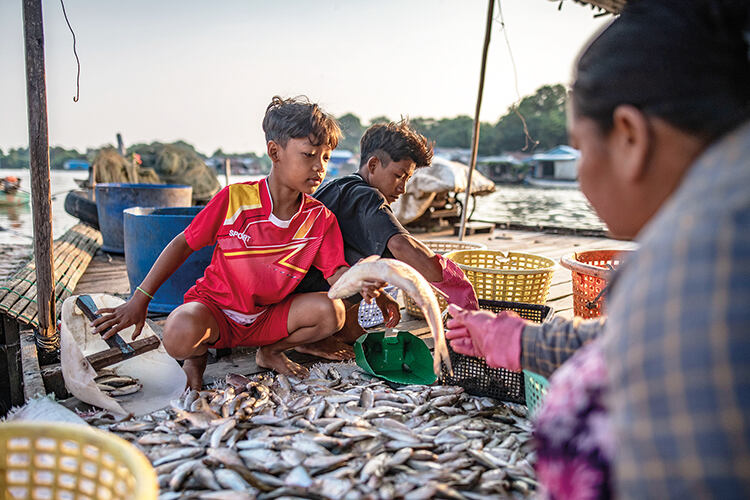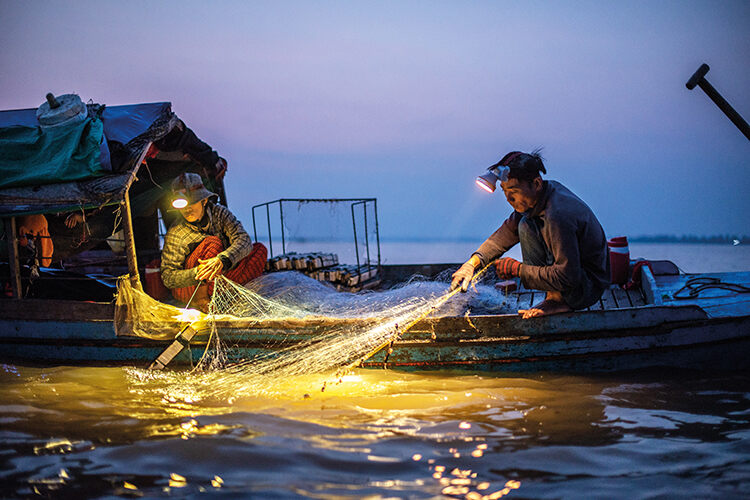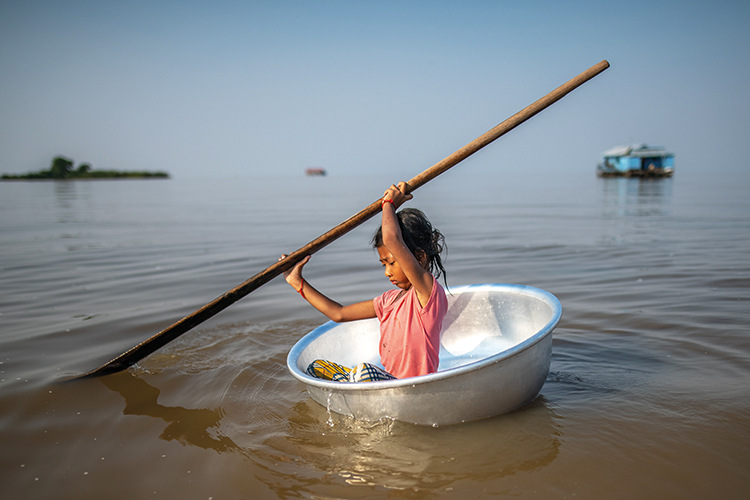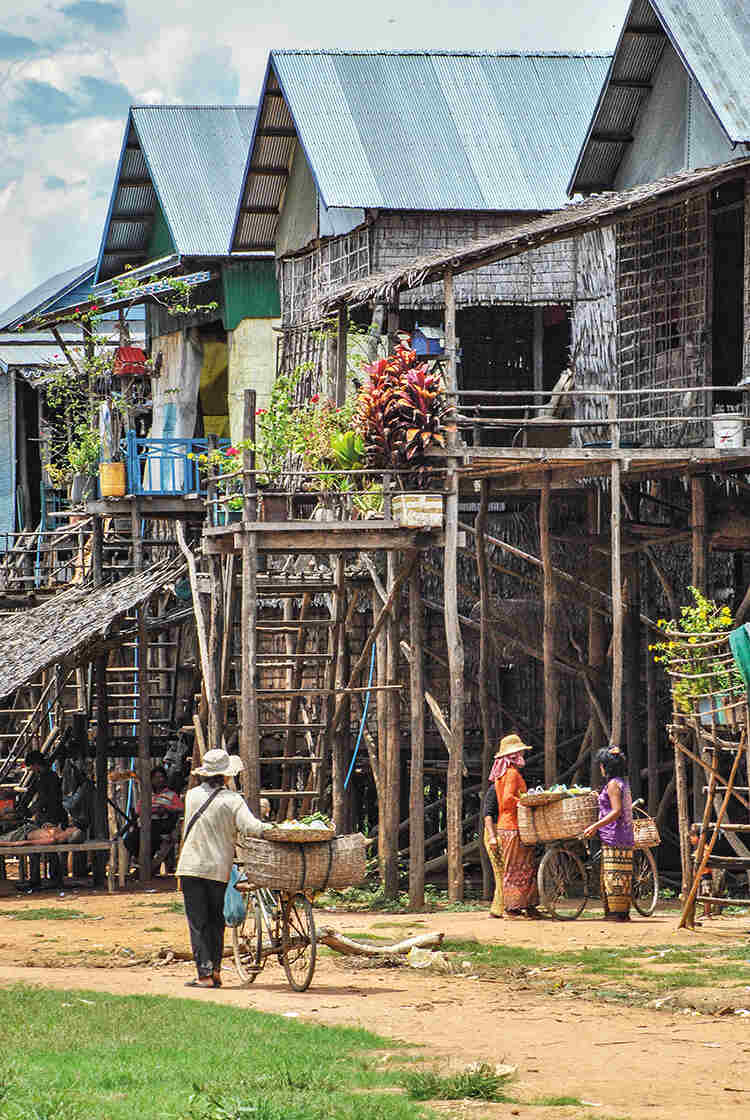
While a dwindling number of people continue to eke out a life fishing in Cambodia’s once bountiful Tonlé Sap lake, many more have been forced to leave for the sweatshops of nearby Phnom Penh or hard labour on plantations in Thailand
It’s early morning in the village of Oakol on Cambodia’s Tonlé Sap lake and the chatter of children’s voices mingles with the rhythmic swish of paddles in water as the sun’s rays creep over the horizon. School is about to begin and a small flotilla of wooden boats helmed by children as young as six is converging on a pair of classrooms floating on oil drums in the middle of the village. The children’s families have lived on the lake for generations and its muddy waters are deeply woven into their identity. Yet now, their ancient way of life is hanging by a thread. Over the past decade, a devastating combination of climate change, illegal fishing and a dam construction spree on the Mekong River and its tributaries has plunged the lake, and the tens of thousands of people who live on it, into crisis.
‘This used to be an easy place to live,’ says 37-year-old Keng Srey Mom, who has spent her whole life in the village. ‘The fish used to literally jump onto our houses and often they weighed two or three kilos, but they’ve been declining for 20 years now.’
Oakol was once home to more than 80 families; just 33 remain. And driven by declining catches and ever-increasing debts, more of its residents are leaving. Some head for the plantations of neighbouring Thailand, others for the garment sweatshops of the capital, Phnom Penh.
‘When people can’t pay back their loans they have to sell their equipment and then they’re forced to migrate,’ says Mom, who runs a small floating shop selling coffee and snacks to supplement her family’s fishing income. ‘If I could leave the lake I would. Every day’s work is just keeping us alive for another day. But I don’t have anywhere else to go.’
Tonlé Sap is subject to an extremely rare phenomenon known as a monotonal flood-pulsed system. For most of the year, its waters flow out into the Tonlé Sap River and down into the Mekong. But for a few months during the rainy season, when the Mekong is swollen with floodwaters, the Tonlé Sap River changes course, sending a deluge of water back upstream into the lake. This increases the lake’s surface area to some 15,000 square kilometres – six times its dry season size – and enriches it with sediment and nutrients from higher up the Mekong basin. To cope with the huge change in water levels, families build their homes on either towering wooden stilts or floating pontoons.

It’s this flood-pulse cycle, which Cambodians like to compare to a heartbeat, that helped to make Tonlé Sap one of the world’s richest freshwater fisheries, an ecosystem so bountiful that early accounts describe people being able to simply scoop up fish in buckets from the porches of their homes. The lake’s wealth fuelled the rise of the empire that built the famous temples of Angkor Wat and it continues to provide protein for millions of Cambodians today.
But now the heartbeat that has long sustained the lake is fading. With dams restricting the flow of the Mekong and erratic weather patterns playing havoc with the annual rainy season, the pulse is becoming irregular. In 2019, the reversal of the river lasted only a few weeks instead of the typical five months. The following year, it barely reversed course at all. The water level has been steadily dropping, and with it, the number of fish. At the same time, rampant illegal fishing has further reduced stocks. The loss through wildfires and deforestation of the extensive flooded forests that once provided a crucial sanctuary for juvenile fish has made the situation even worse.
‘The fish used to be abundant but now we have to fish day and night just to feed our family,’ says Keo Sophanna, a 34-year-old mother of three who, like almost everyone in Oakol, is grappling with crippling debts that grow bigger every year. ‘We took out a loan to buy more nets and when we didn’t catch enough fish, we couldn’t pay it back.’

In total, to purchase fishing equipment and make repairs to their home, the family borrowed six million riels (£1,150), but unable to generate enough income from their fishing, all they can do is cover the interest every month. So far, they’ve paid nearly seven million riels in interest, but they still owe the original six million. Out of two dozen families interviewed by Geographical, every single one said that they were in debt to banks, micro-finance institutions or individual lenders.
On a ramshackle houseboat moored alongside several others on a muddy bank on the lakeshore, 15-year-old Srey Nin cradles her younger sister during a break from fishing. Like many children, Nin was pulled out of school to help her family catch enough shrimp to pay off its debts.
‘The shrimp is cheap but the diesel for the boat is very expensive,’ says Nin’s mother, Vorn Veng. ‘We need loans for our boats and our traps, and when they break, we need more loans to fix them. That’s how it is for everyone here. We want something better, but this is all we know.’

The family used to be able to set 100 traps in a day to catch around 30 kilos of shrimp. Now they have to set as many as 3,000 traps to get the same return. Bringing them all in takes an entire day and requires the help of as many of the children as are able.
‘I’ll always follow my mother,’ says Nin, who has already lost two of her siblings, one to an accident on the lake, another to malnutrition and disease. ‘But I’d rather be in school.’ Of her five remaining siblings, only one is currently enrolled at school. But even with the extra help, the family is still some five million riels in debt. And they estimate that by the time they eventually pay it off, the debt will have doubled.
‘The difference between now and five years ago is like the difference between the Earth and the sky,’ says another fisherman living on a nearby boat, lamenting the crash in shrimp catches.

Some, particularly in the northern part of the lake near Siem Reap and the temples of Angkor Wat, have been able to use ecotourism to partially offset the decline in their fishing income. Others have turned to aquaculture, although this requires capital and the risk of sinking into debt if farmed fish die or escape is considerable. Meanwhile, many families have instead responded by adopting unsustainable and illegal fishing methods, including the use of electric charges and nets with ultra-fine mesh. This creates a vicious cycle that they know will lead to greater problems in the future. Yet many say that it’s the only way that they can survive.
‘If we don’t catch fish, we don’t eat,’ says 59-year-old Vouen Vun, who uses illegal fish traps to help service her debts and support her six children and ailing husband. ‘I don’t know what to do.’
The authorities frequently confiscate her nets, forcing her to pay heavy fines to recover them and adding an extra strain on the family’s precarious finances.

Vun knows her family’s life on the lake is becoming untenable, but she sees few other options.
‘I wouldn’t know what else to do,’ she says, sitting on the wooden floorboards of her floating home, whose walls are covered with plastic wallpaper decorated with butterflies. ‘My great-grandparents lived on the lake. My family has never lived anywhere else. I was born on the water, and so were all of my children.’
Critics say a recent government crackdown on illegal fishing has disproportionately affected the lake’s most vulnerable communities. Meanwhile, corrupt government officials have themselves been implicated in benefitting from large-scale illegal trawling in the interior of the lake. Environmental groups have also accused local government officials of being behind a surge in deforestation in recent years in a scheme that involved clearing areas of flooded forest and then renting the land to farmers to grow rice.
Over the past decade, the government has put in place several comprehensive policies to regulate fishing methods, create protected areas and put a halt to deforestation, but enforcement has been a persistent challenge. A report from the World Wildlife Fund called the measures ‘too little, too late’, adding that some 90 per cent of the region’s freshwater swamp forests had already been destroyed, while those few forests that remain are, ‘heavily modified and degraded.’

At the village level, charities have implemented various initiatives to help individual families cope. In Oakol, the British charity ActionAid helped set up a system of floating gardens where local women can grow vegetables. Another, Conservation International, established a savings group to help mitigate the debt crisis. It also set up a fish-processing facility in the back of Keng Srey Mom’s grocery store, where villagers can produce prahok, a popular fermented fish paste used widely in Cambodian cuisine.
These initiatives have helped increase the resilience of some villages, yet they’re addressing only the symptoms of a worsening disease. The climate is becoming increasingly erratic, the droughts ever more extreme. And while Cambodia finally imposed a moratorium on the construction of further hydro dams on the main stream of the Mekong in 2020, it’s still developing new ones on the river’s tributaries, as are its neighbours to the north.

‘People are facing so many challenges,’ says Puthy San, who heads ActionAid’s work on disaster risk reduction and climate change in Cambodia. ‘Fishermen are having to take their whole families out fishing with them, even the children, and others are being forced to migrate to work in the factories. A lot of people are falling deeper and deeper into debt.’
The fates of most people who live on the lake are now completely dependent on the extent of the annual flood season. In the rare good years, they can endure, but with each bad fishing season their lives become more and more precarious.
‘We’re constantly worried,’ says Han Vy, a mother of seven from the floating village of Phat Sanday. ‘The lake feeds us; it’s a part of us. I don’t know what we’ll do if we have to leave.’




